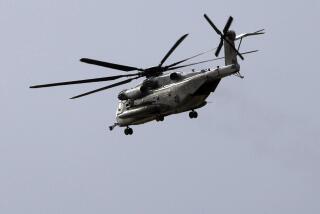Boeing and Sikorsky Get $34-Billion Army Helicopter Program
- Share via
Boeing and Sikorsky won the Army’s $34-billion lightweight helicopter program Friday, dealing a tough setback to a competing team of McDonnell Douglas and Bell Helicopter Textron.
The new helicopter, a twin-engine aircraft intended to replace several thousand scout and light attack models dating as far back as the Vietnam War, is among the Army’s largest projects for the next two decades.
The helicopter contract, along with an advanced tactical fighter contract to be awarded later this year, will generate as many as 300 jobs for TRW’s Rancho Bernardo-based Military Electronics & Avionics Division, which will provide communications, navigation and identification equipment for the light helicopter.
TRW’s locally based division will receive an initial $100-million contract that could rise in value to $750 million to $1 billion, according to TRW spokeswoman Janis Lamar. The future contract additions would probably generate more new jobs in San Diego, Lamar said.
But at $34 billion, the helicopter program faces a difficult future in an era of declining Pentagon budgets and what is likely to be repeated efforts by competing weapons firms to offer lower-cost alternatives, analysts said.
Army Assistant Secretary Stephen Conver said the service plans to buy 1,292 of the aircraft at a projected cost of $34 billion, amounting to roughly $26 million per helicopter. Although cheaper than Air Force fighter jets, the cost is roughly as much as a medium-size passenger jetliner.
As early as next week, the Army is expected to award an initial $2.8-billion contract to launch full-scale development of the so-called LH helicopter, which will include production of several prototypes that will be evaluated before production begins. The first helicopters will not be fielded until 1998.
Because of the slow pace of the program and the potential for future reversals, securities analysts were cautious in their appraisal of the LH project. The program has been scaled back substantially since its inception in 1985, including a reduction just last year that cut future planned purchases to 1,292 from 2,096.
“At its peak, it will generate revenues of $3 billion to be split among the two firms, engine producers and other equipment suppliers,” said UBS Securities analyst Wolfgang Demisch. “Still, this is a major win and will allow Bell and Sikorsky to expand their engineering capabilities.”
Sikorsky, a subsidiary of United Technologies and the nation’s largest producer of helicopters in terms of revenues, is located in Stratford, Conn. Boeing’s helicopter unit is located in Philadelphia. Boeing spokesmen could not say where final assembly of the aircraft would be located.
The contract award “is extremely rewarding for the many dedicated TRW employees who have turned a vision into reality” at TRW, which has spent 10 years developing the technology to be used in the light helicopter program, said Roy J. Adams, vice president of TRW’s Military Electronics & Avionics Division.
In addition to the helicopter contract announced on Friday, TRW’s locally based division expects to win all or part of an electronics contract later this month in connection with the U.S. Air Force’s Advanced Tactical Fighter.
TRW’s electronic equipment is designed to help pilots communicate with friendly forces, identify foes, navigate to and from targets, and detect and avoid threats.
TRW will handled engineering work on both contracts in Rancho Bernardo, but manufacturing will take place at a Colorado Springs plant.
Word of the contract was welcomed by TRW, which has laid off more than 200 people during the past year, Lamar said.
Securities analysts had favored the McDonnell and Bell team, owing to their greater experience in producing armed combat helicopters. McDonnell produces the Apache in Mesa, Ariz., and Bell produces the Cobra in Ft. Worth. Sikorsky and Boeing are leaders in large transport helicopters for the Marines and Navy.
For McDonnell, the loss compounds a series of recent setbacks and substantially raises the stakes for the upcoming award of the Air Force’s advanced tactical fighter program, in which the firm is teamed with Los Angeles-based Northrop.
If McDonnell is not successful in the ATF program, it would face a declining future in both helicopters and fighter jets. The Army’s Apache program will end in 1993. And the Air Force is planning to end production of the F-15 within several years, as well.
“It is a major disappointment for McDonnell,” analyst Demisch said. “McDonnell is going to have to cut back its level of activities in helicopters substantially.”
McDonnell Douglas Helicopters President Thomas Gunn said Friday that the “loss of the program does not change the positive projection for the company’s financial growth or negatively impact McDonnell Douglas Corp.’s financial position.” McDonnell employs 4,700 in Mesa and 1,400 in Culver City.
Gunn said the firm will deliver 172 more Apaches by the end of 1993 and produce 100 MD500 commercial helicopters by 1995. He also said deliveries of a new commercial MDX helicopter will begin in 1994.
The new LH helicopter is intended to be more survivable than its predecessors while operating deep behind enemy lines. It features a rear tail rotor embedded into the aircraft’s rear tail boom.
McDonnell had proposed a revolutionary idea of using an air circulation system to entirely eliminate a rear rotor, but the concept had developed technical problems, Demisch said. But he could not say how much these problems contributed to the loss of the program.
Times staff writer Greg Johnson in San Diego contributed to this story.
More to Read
Inside the business of entertainment
The Wide Shot brings you news, analysis and insights on everything from streaming wars to production — and what it all means for the future.
You may occasionally receive promotional content from the Los Angeles Times.











